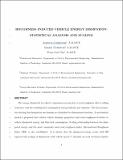| dc.contributor.author | Louhghalam, Arghavan | |
| dc.contributor.author | Tootkaboni, Mazdak | |
| dc.contributor.author | Ulm, Franz-Josef | |
| dc.date.accessioned | 2017-07-12T18:44:54Z | |
| dc.date.available | 2017-07-12T18:44:54Z | |
| dc.date.issued | 2015-11 | |
| dc.identifier.issn | 0733-9399 | |
| dc.identifier.issn | 1943-7889 | |
| dc.identifier.uri | http://hdl.handle.net/1721.1/110690 | |
| dc.description.abstract | The energy dissipated in a vehicle suspension system due to road roughness affects rolling resistance and the resulting fuel consumption and greenhouse gas emission. The key parameters driving this dissipation mechanism are identified via dimensional analysis. A mechanistic model is proposed that relates vehicle dynamic properties and road roughness statistics to vehicle dissipated energy and thus fuel consumption. A scaling relationship between the dissipated energy and the most commonly used road roughness index, the International Roughness Index (IRI), is also established. It is shown that the dissipated energy scales with IRI squared and scaling of dissipation with vehicle speed V depends on road waviness number w in the form of V[superscript w−2]. The effect of marginal probability distribution of the road roughness profile on dissipated energy is examined. It is shown that although the marginal distribution of the road profile does not affect the identified scaling relationships, the multiplicative factor in these relationships does change from one distribution to another. As an example of practical application, the model is calibrated with the empirical HDM-4 model for different vehicle classes. | en_US |
| dc.language.iso | en_US | |
| dc.publisher | American Society of Civil Engineers (ASCE) | en_US |
| dc.relation.isversionof | http://dx.doi.org/10.1061/(asce)em.1943-7889.0000944 | en_US |
| dc.rights | Creative Commons Attribution-Noncommercial-Share Alike | en_US |
| dc.rights.uri | http://creativecommons.org/licenses/by-nc-sa/4.0/ | en_US |
| dc.source | Other repository | en_US |
| dc.title | Roughness-Induced Vehicle Energy Dissipation: Statistical Analysis and Scaling | en_US |
| dc.type | Article | en_US |
| dc.identifier.citation | Louhghalam, Arghavan, Mazdak Tootkaboni, and Franz-Josef Ulm. “Roughness-Induced Vehicle Energy Dissipation: Statistical Analysis and Scaling.” Journal of Engineering Mechanics 141.11 (2015): 04015046. | en_US |
| dc.contributor.department | Massachusetts Institute of Technology. Department of Civil and Environmental Engineering | en_US |
| dc.contributor.mitauthor | Louhghalam, Arghavan | |
| dc.contributor.mitauthor | Ulm, Franz-Josef | |
| dc.relation.journal | Journal of Engineering Mechanics | en_US |
| dc.eprint.version | Author's final manuscript | en_US |
| dc.type.uri | http://purl.org/eprint/type/JournalArticle | en_US |
| eprint.status | http://purl.org/eprint/status/PeerReviewed | en_US |
| dspace.orderedauthors | Louhghalam, Arghavan; Tootkaboni, Mazdak; Ulm, Franz-Josef | en_US |
| dspace.embargo.terms | N | en_US |
| dc.identifier.orcid | https://orcid.org/0000-0002-6581-5986 | |
| dc.identifier.orcid | https://orcid.org/0000-0002-7089-8069 | |
| mit.license | OPEN_ACCESS_POLICY | en_US |
| mit.metadata.status | Complete | |
